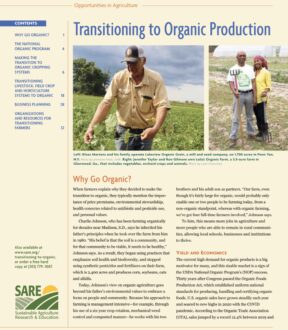Since the 1990 Organic Foods Production Act passed, the market for organic products has steadily risen. In 2020, organic sales skyrocketed to an all-time high, motivating many farmers to consider transitioning their farms to organic production. While organic production can help farmers gain access to new markets, improve soil and increase profits, the transition process can be both challenging and risky.
SARE’s newest bulletin, Transitioning to Organic Production, explains how many farmers adopt organic production to increase profits while improving the resilience and environmental impact of their production systems. Long-term success requires patience, flexibility, good record-keeping and a commitment to stewardship.
Transitioning to Organic Production lays out basic transition strategies for livestock, field crop and horticultural systems, including a summary of the certification process and the National Organic Program standards. Practices common to all organic systems are also addressed, including:
- crop rotation
- cover cropping
- addition of organic fertility sources
- disease prevention
- integrated pest and weed management
- conservation tillage
Transitioning to Organic Production also outlines how these research-based practices, paired with sound transition strategies such as flexible timelines, using alternative labels and coordinating with NRCS programs, can help farmers successfully navigate the transition process. Download or order your free print copy of Transitioning to Organic Production at https://www.sare.org/transition-to-organic or by calling (301) 779–1007. Transitioning to Organic Production is available in quantity for free to educators for use in educational workshops, classes or tours.
